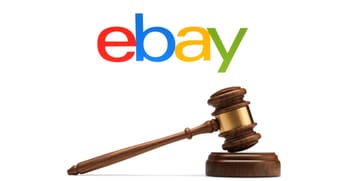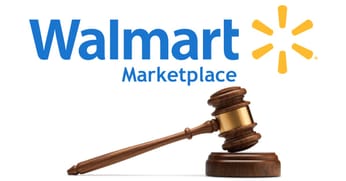eBay's Q4 GMV Gambit: Big Discounts To Convert Sellers Into Enthusiast Buyers
All eBay wants for Christmas is a GMV and Active Buyer bump, and it appears they're willing to spend big in an attempt to turn casual sellers into "enthusiast buyers" with hefty discount coupon offer.
The company's stock price dipped last month when Q3 2024 earnings revealed weaker revenue guidance for Q4 than eBay had previously provided.
While the report showed "modest growth" in both GMV and Active Buyers, it also showed increasing pressure on revenue, largely driven by "phased monetization of UK C2C initiative" - ie. fee-free private selling across most categories, with buyer fees still expected to be introduced in the back half of Q1 2025.

It was nice to see eBay eke out a tiny Active Buyer "win", going from being stuck at 132 Million for 5 quarters to 133 Million in Q3, but it's worth noting there's still a lot of lost ground to make up as eBay has now had 10 consecutive quarters with less Active Buyers than Q1 2018.
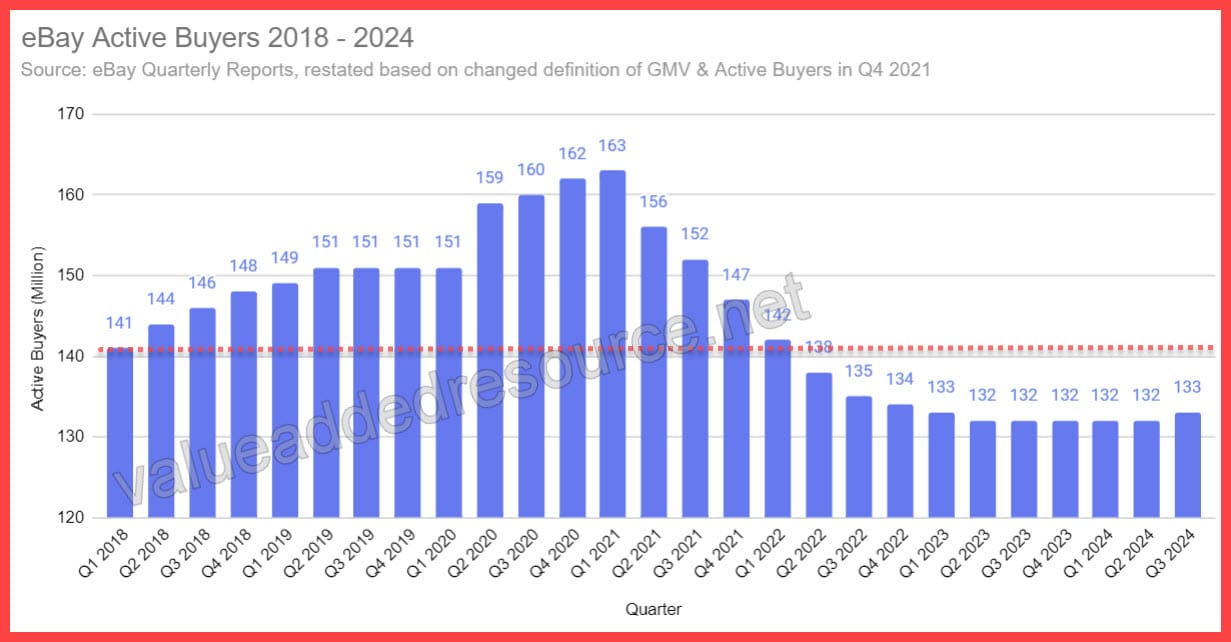
But within that larger Active Buyer stat, CEO Jamie Iannone has focused a lot of attention, and marketing dollars, around what he calls "high value enthusiast buyers" - generally defined as buyers who shop on eBay at least 6 times per year, spend at least $800 per year or those who also sell on the site.
Despite these enthusiast buyers being the target of Iannone's "focus vertical strategy", building new experiences (and again spending lots of marketing dollars) to build up categories like sneakers; trading cards; luxury handbags, jewelry and watches; auto parts and refurbished electronics, the number of "enthusiast buyers" has also been stalled for many quarters, stuck at ~16 Million since Q4 2022.
That means the small amount of buyer growth eBay has seen doesn't appear to be bringing in a lot of new "enthusiasts" to the platform.
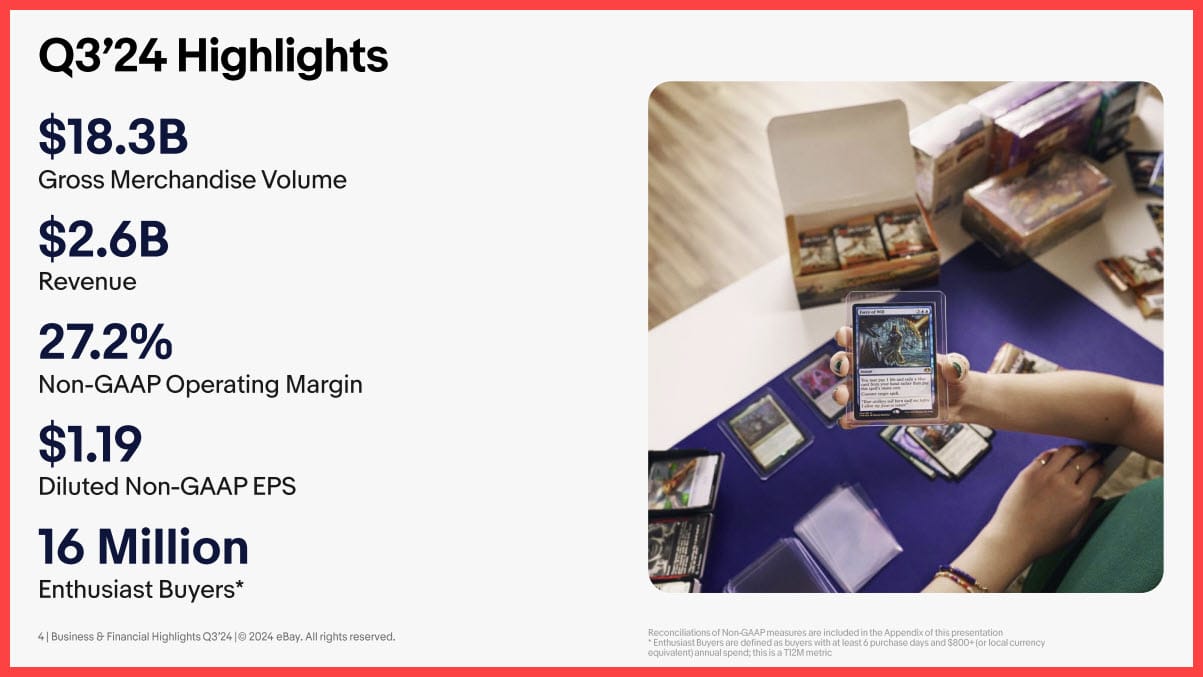
eBay was already pulling out the stops to try to "buy" GMV and Active Buyer growth in Q4 by introducing fee-free selling in the UK across most categories in October, sacrificing some revenue in order to get the other stats up.
But Iannone didn't tell investors on the Q3 call that eBay has also been forced to turn to offering 0% fee promotions through the end of the year in some categories to business sellers as well, in order to try to quell backlash from the C2C initiatives and keep sellers from defecting to Vinted Pro.
The willingness to give up fee revenue in order to boost GMV and Active Buyers is an interesting strategy - particularly since Iannone had been highly critical of previous CEO Devin Wenig's frequent discounts (paid by eBay) to try to attract more buyers in 2018-2019.
Those 15-20% off flash sales proved to be a double edged sword - once buyers get used to receiving discounts, they'll often wait for a sale before making a purchase, creating "one and done" or only occasional buying patterns.
Wenig's strategy was considered such a failure that Iannone felt the need to explicitly distance himself from it when he took the helm, telling investors in 2021:
We've discontinued legacy tactics that led to low value, infrequent or one and done buyers. Our buyer base is starting to evolve based on this strategy. These high-volume buyers are growing compared to a year-ago and their spend on eBay is growing even faster. This higher-quality mix of buyers increases value for sellers and will lead to improved health of our ecosystem over the long-term...
..This is something that I laid out last July when we talked about the tech-led reimagination as being focused on turning buyers into lifelong enthusiasts on the platform and moving away from the tactics that we had in 2019 what was really just about the number of active buyers even low value buyers or one and done buyers.
However, despite his criticism of those past tactics, it's hard not to see that eBay is increasingly putting themselves in a similar position with sellers and fees.
Business sellers could become habituated to frequent discounts, just like buyers did, and hold back some inventory until a fee discount or promotion is offered.
Now, eBay is taking it a step further, hoping to secure an increase in those critical "enthusiast buyers" by specifically incentivizing new sellers to become buyers too, offering a $15 coupon to spend on a purchase of $50 or more, if they sell an item for $10+.
A Value Added Resource reader sent a screenshot of the offer, though it's not clear how many users are eligible or what the exact criteria to receive the promotion is.
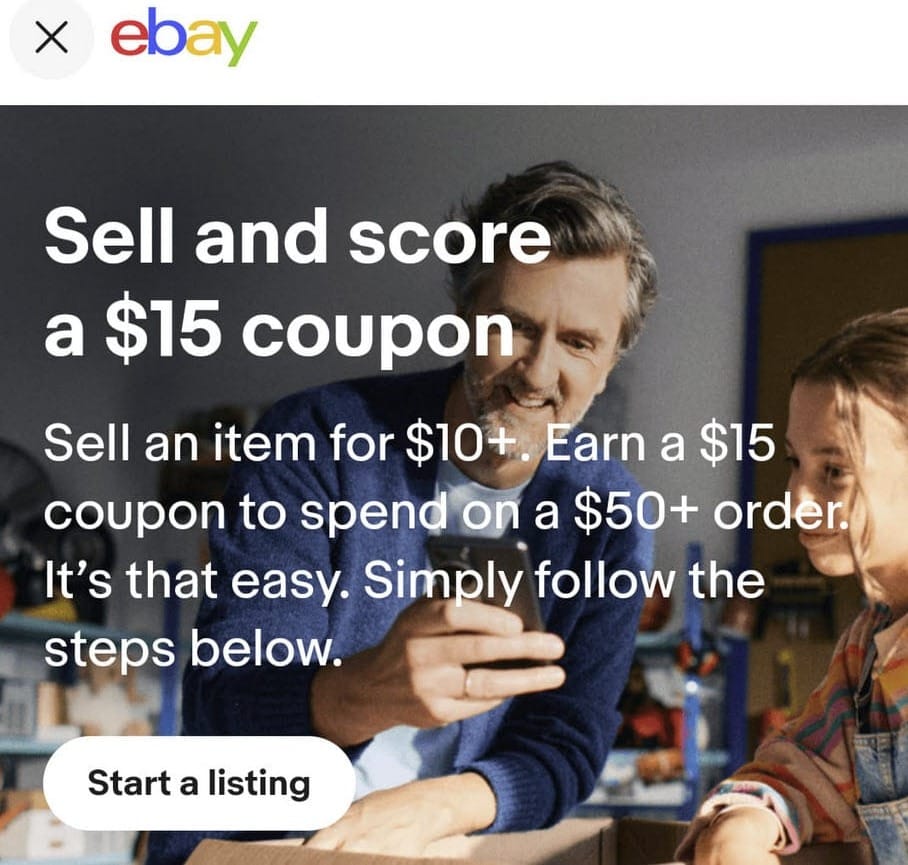
For the sake of keeping the math easy, if someone were to use that $15 coupon on a $50 order, that would work out to a 30% discount - significantly higher than Wenig's 15-20% flash sales.
As part of the fee-free selling changes in the UK, eBay also introduced eBay Balance, forcing private sellers into a payment structure which defaults to keeping funds on account where they can be used to pay for future purchases while turning withdrawing funds to a bank account into a needlessly difficult and complex manual process.
Many sellers in the UK suspect that update was designed to introduce just enough friction into the payout process to "encourage" keeping funds circulating on the site, while of course also earning interest for eBay, sparking concerns about dark pattern design practices possibly being baked into this new feature.
While gaining more "enthusiast buyers" who also sell on the site is a worthy goal for the company (and may even be worth allocating additional marketing or discount dollars), as always the devil is in the details and execution.
In order to gain user trust to keep those buyers who also sell active on the site, transparency is absolutely paramount - and adding friction to the payout process to obtain desired results is the exact opposite of what eBay needs to be doing here.
Transparency is of critical importance for eBay's relationship with its shareholders too.
If Iannone is confident his fee-free strategy for private sellers in the UK, fee waivers or discounts for some business sellers and ~30% coupons to incentivize new sellers to also buy will create long-term, sustainable GMV and Active Buyer growth without the significant downside risks he criticized his predecessor for taking, then he should have no problem candidly discussing how much any (presumed) growth in those areas can be attributed to these initiatives as well as costs and return on investment on the next earnings call.
If instead he and/or CFO Steve Priest try to present any (presumed) growth as a magical Christmas miracle or proof their "strategy is working" while not disclosing any of that crucial context - investors would be wise to dig deeper, demand honesty and transparency, and take a hard look at the near to long-term prospects for the company if eBay remains under current leadership.


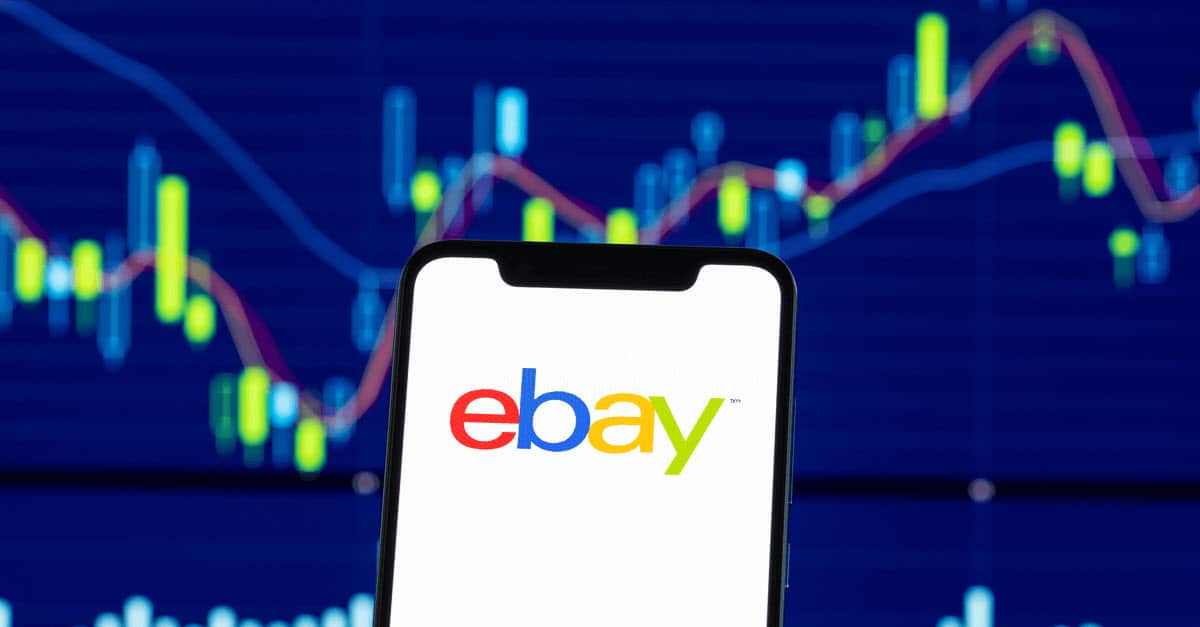

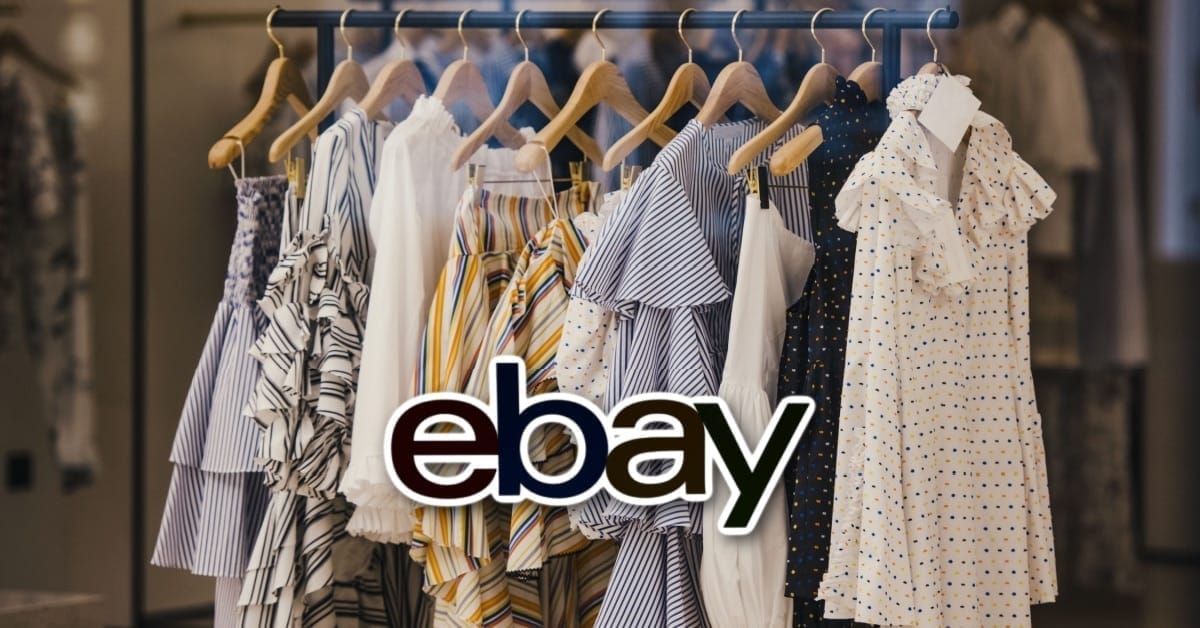

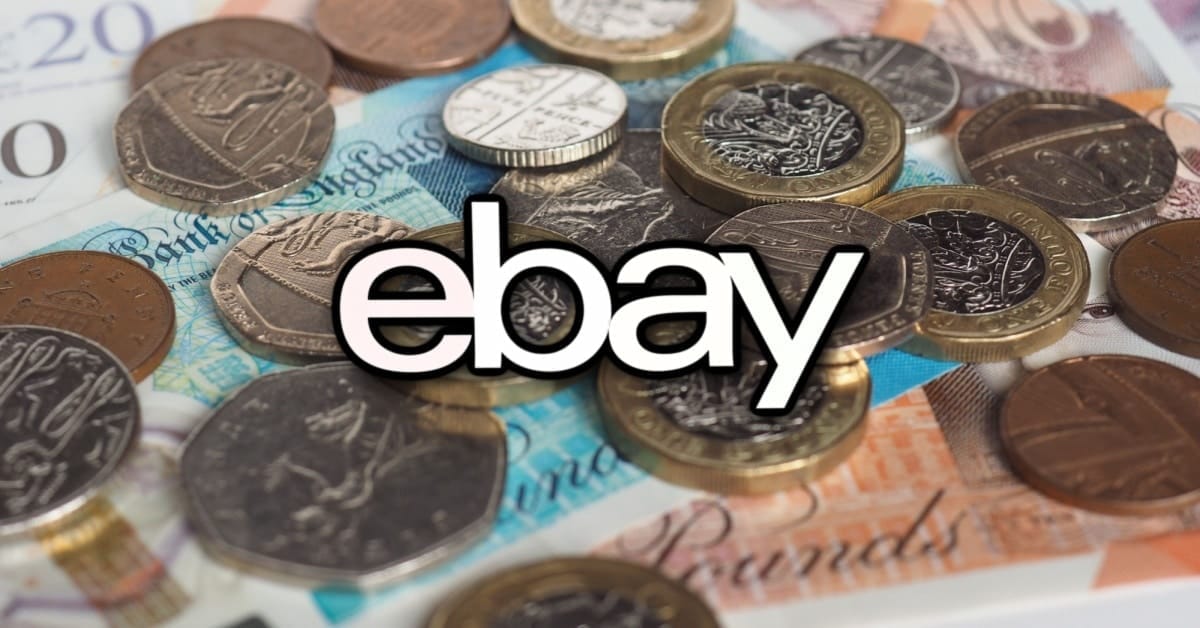

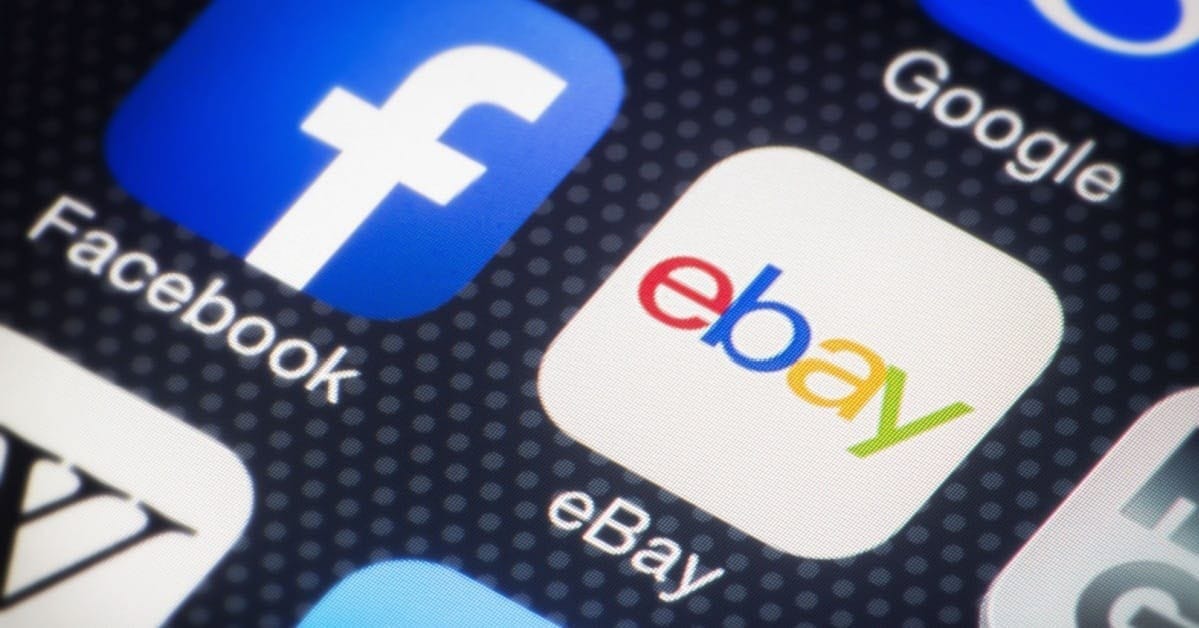

 ZippyBuysStuff
ZippyBuysStuff


